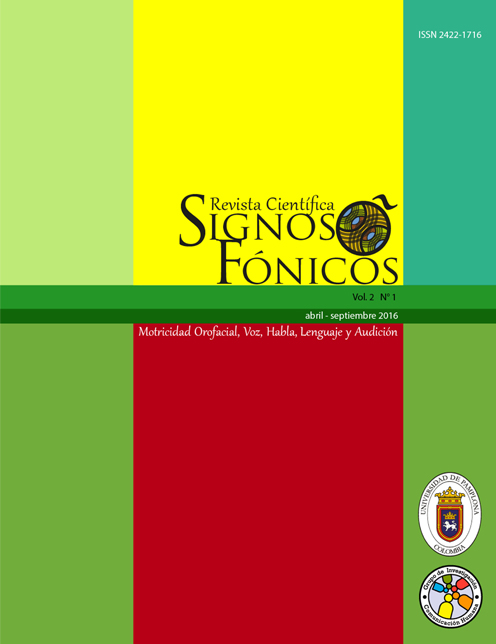Medidas de vouce onset time (vot) para oclusivas españolas en estudiantes universitarios: nuevas aproximaciones de análisis
DOI:
https://doi.org/10.24054/rcsf.v2i1.2100Palabras clave:
Habla, Acústica, EstudiantesResumen
INTRODUCCIÓN: El objetivo del trabajo es construir medidas de referencia para el VOT del español hablado en la zona nororiental de Colombia a partir de una población de estudiantes universitarios. MÉTODOS: Estudio descriptivo transversal, la selección de la población fue aleatoria a partir de muestreo estratificado. El numero total de participantes fue de 35, 17 mujeres y 18 hombres. Las muestras acústicas se tomaron en una cabina sonamortiguada usando un micrófono unidireccional. Los datos obtenidos recibieron análisis de tendencia central y de correlación canónica. RESULTADOS: Las medias de VOT para las oclusivas sordas en la población fueron: (1) /p/ 15,70 s.; (2) /t/ 15,56 s.; (3) /k/ 30,38 s. ANÁLISIS Y DISCUSIÓN: No se encontró relación estadística
significativa entres VOT con edad, género o lugar de procedencia. El VOT cambi de forma significativa en presencia de los sonidos /i/, /e/ en razón al efecto coarticulador de estos sonidos. CONCLUSIONES: Es necesario ampliar los participantes del estudio a fin de indagar sobre los efectos de la varión regional del español colombiano sobre VOT. Se recomienda utilizar como estrategia
de normalización del VOT en futuros estudios una toma triple para cada ingreso de datos.
Descargas
Referencias
Abranson AS, Lisker L. Voice onset time in stop consonants: acoustics analysis and syntesis. 1965..
Karlsson , K. , Unger E, Wahlgren S, Blomstedt P, Linder J, et al. Deep brain stimulation of caudal zona incerta and subtalamic nucleus in patients with parkinson`s disease: effects on diadochokinetic rate. Parkinson’s Disease. 2011; 2011.
Martinez Celdran E. Análsis espectrográfico de los sonidos del habla. 2nd ed. Barcelona: Ariel; 1998.
C. Ö, P.a A, M •J, D. H. Measurement of Voice Onset Time in Dysarthric Patients: Methodological Considerations. Folia phoniatrica et logoaedica. 2001; 53(1): p. 48-57.
Karlsson F, Olofsson K, Blomstedt P, Linder J, Nordh E, van Doorn J. Articulatory Closure Proficiency in Patients With Parkinson’s Disease Following Deep Brain Stimulation of the Subthalamic Nucleus and Caudal Zona Incerta. Journal of speech language hearing research. 2014; 57(4): p. 1178-1190.
Kim Y, Kent R, Weismer G. An acoustics study of relationship among neurologis disease, dysarthria type, and severity of dysartria. Journal of speech language and hearing research. 2011; 54(2): p. 417-429.
Gopi Sankar R, Pushpavathi M, V.H S. Voice Onset Time (VOT) in Kannada Speaking Children with Cleft Palate: A Pre- and Post-Operative Comparison. Language in india. 2014; 14(2).
Eshghi M, Bijankhn M, Shirazi M, Nourbakhsh M. Impact of place of articulation in VOT for iranian cleft palate children. In International Congress of Phonetic Sciences (ICPhS) ; 2011; Hong Kong: ICPhS.
Casillas JV, Díaz Y, Simonet M. Acoustics of Spanish and English coronal stops. In 18th International Congress of Phonetic Sciences; 2015.
Ogut F KMEEMR. Voice onset times for turkish stop consonants. Speech Communication. 2006; 48(9): p. 1094-1099.
Modarresi Ghavami G. The effects of sillabe boundarry, stp consonats closure duration, and vot on vcv coarticulation. 2002 Dec..
Hoole P, Gobl C, Ní Chasaide A. Laringeal coarticulation. In Hardcastle W, Hewlett N. Coarticulation: theory, data, and techniques. New York: Cambridge University Press; 2006.
Mammartströn I, Larsson M, Wiman S, McAllister , A. Voice onset time in swedish children and adults. Logopedics, Phoniatrocs, Vocoloy. 2012; 37(3): p. 117-122.
Lara Diaz M, editor. Calidad de vidad en el envejecimiento normal y patológico: una perspectiva terapèutica Bogotá: Editorial Universidad Nacional de Colombia, Facultad de Medicina; 2011.
Guenther F. Cortical interactions undrlying the production of speech sounds. Journal of Communications Disorders. 2006; 39(5): p. 350-365.
Guenther F, Strajit S. G, Tourville J. Neural modeling and imaging of the cortical interactions underlying sillabe production. Brain & Language. 2006; 96(3): p. 280-301.
Rothenberg M. Voice onset time versus articulatory modeling for stop consonants. Logopedics, Phoniatrics, Vocology. 2009; 34(4): p. 171-180.
Bosch Galceran L. Evaluación fonológica del habla infantil Barcelona: Masson; 2004.
Liss JM,WG&RJC. Selected acoustic characteristics of speech production in very old males. Journal of Gerontology. 1990;(5, 35-45.).
Petrosino L,CRD,KKB&RJ. Voice onset time of velar stop productions in aged speakers. Perceptual and Motor Skills. 1993;(76, 83–88).
L. DMF. CALIDAD DE VIDA EN EL ENVEJECIMIENTO NORMAL Y PATOLÓGICO: UNA PERSPECTIAVA TERAPÉUTICA. UNIVERSIDAD NACIONAL DE COLOMBIA, 1ra Edición. 2011.
ABRAMSON ASyLL. A Cross-Language Study of Voicing in. 1964 December; Nº 20(3).
Xue SA&HGJ. Changes in the human vocal tract due to aging and the acoustic correlates of speech production: A pilot study. Journal of Speech, Language, and Hearing Research. 2003.
Guenther H, Hampson M, Johnson D. A theorical investigation of reference frames for planning of speech movements. Phycological Review. 1998; 105(4): p. 611-633.
Poch MD. Datos acústicos para la caracterización de las oclusivas sordas en el español. Folia Phonetica. 1984; 1( 89-106).
Castañeda ML. El VOT de las oclusivas sordas y sonoras. Estudios de Fonética Experimental. 1986; 2(92-110).
Asensi LSPyAdR. Barra de explosión, VOT y frecuencia de las oclusivas sordas en el castellano. Estudios de Fonética Experimental. 1997; 9.(221-242).
PERKELL JSyMM. Temporal measures of anticipatory labial coarticulation for the vowel /u/:within- and cross -subject variability. Journal of the Acoustical Society of America. 1992; 91.
Bernal BJ BSGV. Reconocimiento de Voz y Fonética Acústica. Alfamega. 2000.
Frank H. Guenther1 2SSGaJAT. Neural Modeling and Imaging of the Cortical Interactions Underlying Syllable Production. Brain & Language Department of Cognitive and Neural Systems, 677 Beacon St., Boston University. 2006.
Real Academia Española. Nueva gramática de la lengua española. Fonética y fonología Barcelona: Espasa Libros; 2011.
Descargas
Publicado
Número
Sección
Licencia
Derechos de autor 2016 Heriberto Rangel Navia, Asbleidy Carolina Torres Barbosa, Brayan Jesus Mojica Galeano

Esta obra está bajo una licencia internacional Creative Commons Atribución-NoComercial 4.0.











